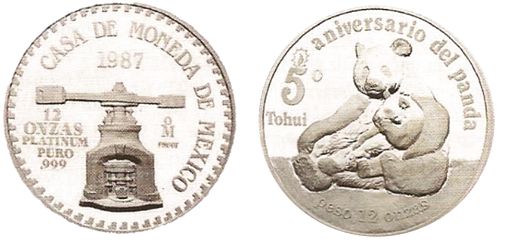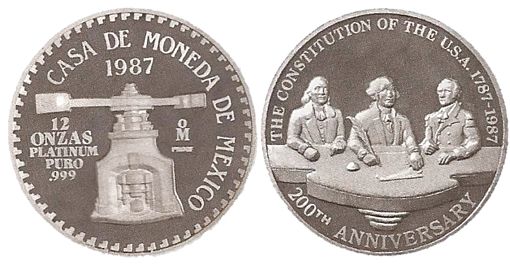The Pillar/Coining Press Medal and its Historical Background
by Pablo Luna Herrera
The production of medals by the Mexican Mint in the last quarter of the 20th century is very interesting, with a proliferation of privately commissioned medals, commemorative pieces for the Legaria, Apartado and San Luis Potosí plants, the introduction of bimetallic designs and the perfection of proof strikes.
The purpose of this article is to make an analysis of one medal that is not usually seen. This piece also has very attractive designs on both sides, in my opinion emblematic designs for the contemporary Mexican medalist.
This investigation started when I had the opportunity to see a piece that by its characteristics puzzled me, a cupronickel ounce, proof, with the Spanish Milled design on one side and on the other the famous coin press of the Mexican Mint.
Let us start by studying each side of this piece. The obverse corresponds to the famous Spanish Milled design, like a coin that began to be produced in the Mexican Mint in 1732 (patterns exists from 1729). But the modern reproduction that this medal shows was created in 1988 specifi cally at the XIV Numismatic Convention in Mexico City. This event was attended by a lot of international numismatics personalities, one of them the president of the Money Company. Mr. Richard Nelson, who liked the Milled design very much, possibly because it was legal tender in the U.S. for decades. In 1988 he asked the Mexican Mint to strike 4,800 5 oz. proof pieces of the famous Milled Dollar.
The medal was a great success and the Mint started to mint the same piece in diff erent sizes (12, 5, 1, ½, ¼, 1/10 oz.). There was also a mint set for foreign customers with all the medals, except the 5 oz.
The Mexico Mint continues producing and selling all these sizes. Even in the last year they announced a new Milled Medal design with a gold plated obverse, up to the 1 oz. piece. It is to be supposed that all the medals coined today are not from 1988 but are modern re-strikes.
Furthermore at the same event, the Mint produced one hundred very interesting medals with the same design as the 5 oz. but piedfort type (i.e. with the same diameter as the 5 oz. but with a 10 oz. weight). These piedfort specimens were only sold to dealers who had tables at the convention and today are very scarce.
1988 silver 12 oz. Replica Pillar of 1732
On the reverse of the medal we have the coining press, the screw press mechanism that revolutionized the system of striking coins over the whole world. This was introduced in Spain by King Philip V (1700-1746), at the Madrid and Seville mints in 1700 and at Segovia in 1772 almost half a century later than the Paris and London mints. This mechanism arrived at the Mexico City mint in 1728 and the mint began to strike milled silver coins in 1732.
In the annals of Mexican numismatics we can fi nd this design used for the fi rst time in 1935, for the fourth centenary of the Mexican Mint. This coining press design was designed by Manuel Luna Negrete. For decades it was used for the famous Troy Ounces, beginning in 1947.
It is very engaging to look at the evolution of this design in the 80s
1986 Silver 5 oz. 450th anniversary of the first mintage
 1987 Silver 12 oz. Panda Tohui series
1987 Silver 12 oz. Panda Tohui series
 1987 Platinum 12 oz. 200th anniversary of the United States constitution
1987 Platinum 12 oz. 200th anniversary of the United States constitution
1987 Silver 12 oz. Summer Olympic Games
1989 Silver 1 oz. “onza del caprichio”
N. D. Cupronickel 1 oz.
We know that the obverse of this medal is the same used in the Milled modern medal of 1988, but the reverse is interesting. Personally, I found three big differences between the Pillar/Coining Press medal and other examples:
1. The date. It does not have the year date.
2. The position of the mint mark (Mo). In all the pictures the mint mark is on the right or absent: in this medal the mint mark is on the left.
3. The typeface of CASA DE MONEDA DE MEXICO. There are two styles; the second used on this medal is more elaborate than the fi rst, used since the Troy Ounces series.
More amazing is a seventh medal, which through its reverse is connected to this medal. We can conclude that this medal is a mule (i.e. a single piece that uses two dies used previously in diff erent coins or medals, in other words the observe of one type with the reserve of another).
This Cuauhtémoc/Coining Press medal was struck at the request of Colonial Coins, a company in Houston Texas. It is a silver 0.720 proof ounce dated 1988.
Now that we have analyzed both sides of this Pillar/Coining Press medal we should consider another very unusual factor - the metal, cupronickel.
Cupronickel is not commonly used in medals and more so those in proof fi nish. There are two reasons to mint in this metal. If we study the circulating coins in Mexico in this period of time a lot of the denominations are also in cupronickel, with the classic alloy that the Mexican Mint used for decades of 0.75 copper and 0.25 nickel. Secondly, this medal was not to satisfy a private request, but struck on the Mexican Mint’s own initiative with the objective of presenting this medal at the International Numismatic Exposition in Orlando, Florida, in 1992, to celebrate the fifth centenary of the encounter between two worlds (this explains the Spanish Milled design that represents also the union of America and Europe across the ocean). For economic, legal and fiscal reasons it was more convenient to export pieces of industrial materials like cupronickel.
The mintage of this medal was 500 pieces. But the existence of a silver 0.999 identical piece has been confirmed. I continue to investigate the mintage of the silver piece, and I do not discount the existence of this piece in another metal.
The edge is plain. Additionally a curious fact is that this medal has three mint marks, two on the obverse and one on the reserve.
| Data sheet of the Pillar/Coining Press medal | |
| Metal: Copper-nickel (Silver exist) | Diameter: 38mm |
| Weight: 27 grams | Mintage: 500 pieces (silver in research) |
| Edge Plain | Date: 1992 |
